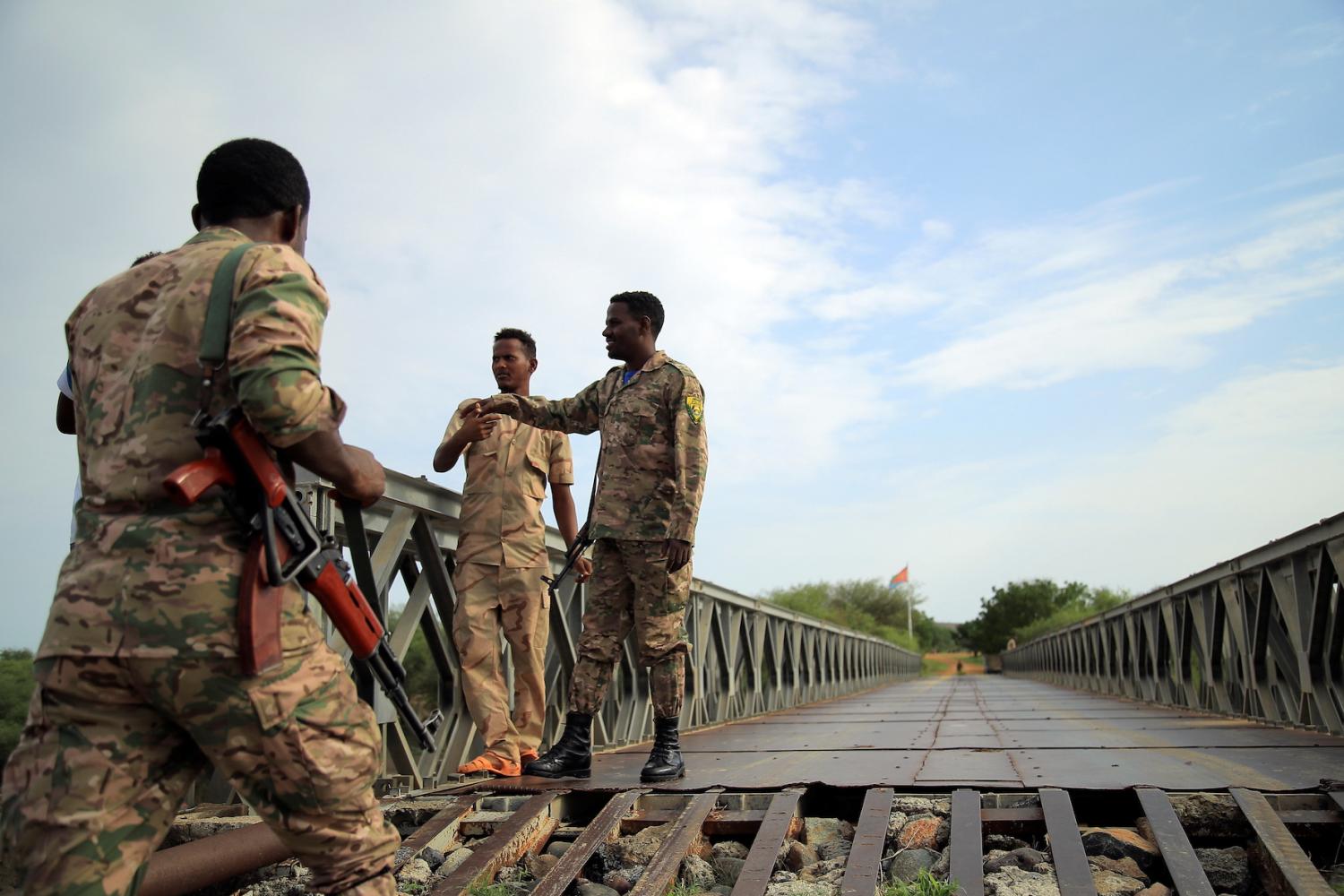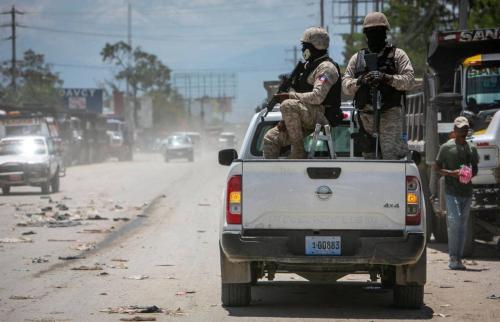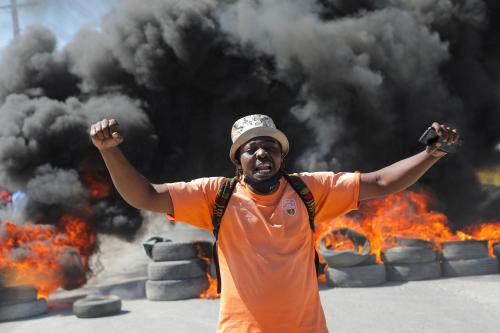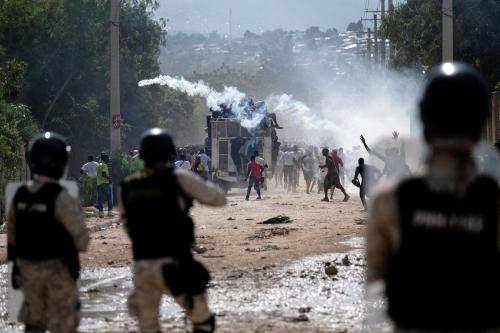This piece is part of a series titled “Nonstate armed actors and illicit economies in 2024” from Brookings’s Initiative on Nonstate Armed Actors.
On February 7, Haiti is bracing itself for a political crisis and possibly re-intensified violence. The first few weeks of 2024 have seen a spike in protest activity, with marches, barricades, and burning tires paralyzing towns across Haiti. Further protests have been promised to demand the departure of acting Prime Minister Ariel Henry after February 7, a highly symbolic date specified in the Haitian Constitution for transfers of power.
Mired in political deadlock
Over the past year, the government of the acting prime minister has been nominally operating under the framework of an agreement concluded on December 21, 2022, that set the goal of organizing elections in 2023 in time for a new government to be inaugurated on February 7, 2024. But with elections having never happened—in fact, without even the appointment of a temporary electoral council, as established in the agreement—the opposition is gearing up to push for Henry’s departure on February 7, arguing that the agreement promises his exit, even if key conditions haven’t been met.
Efforts over the past year to craft a broadened or new agreement have faltered. Negotiations led over the summer and fall by a group of three Caribbean former leaders, known as the Eminent Persons Group (EPG), resulted in a December proposal that was rejected by the opposition, since it maintained Henry in the prime minister’s role and proposed a five-member council with limited powers as a substitute for a president, a position vacant since President Jovenel Moïse’s assassination in July 2021. The EPG offered to return to continue negotiations once the Henry government and the opposition had advanced their rapprochement, but the two sides have reportedly not sat down together since the last negotiations in December.
Other last-ditch efforts to rescue the December 21, 2022 agreement, for example by promulgating an addendum to extend its lifespan, seem to have failed. Positions have only hardened. The leaders of the Montana Group, which in August 2021 proposed a two-year transition agreement, have refused to negotiate further with the government, exacerbating the frustration of the U.S. government, and increasingly many Haitians, with the group’s rigid stance. One challenge is that many opposition groups, possessing little electoral or financial support, are incentivized to remain in opposition. For example, while the Montana Group’s leadership enjoys support from a broad coalition of civil society actors, and favorable press relationships in Haiti and abroad, they do not represent a political platform or party and therefore are less likely to benefit from a rapid move toward elections. They, and other opposition groups, therefore, have more to gain in negotiating power from Henry’s likely increase in illegitimacy after the expiration of the February 7 deadline.
At the same time, the country is moving further and further away from constitutionality, which it arguably left behind following Moïse’s assassination, if not before. Elections were last held in 2016, and all elected officials’ terms have subsequently expired. The fractures in the Haitian political scene mean that elections are seen as vital to establishing a government that possesses sufficient legitimacy to begin tackling the country’s many looming challenges.
A political player reenters the scene
And now there is a new wild card with the return of Guy Philippe, a leader of the 2004 coup who was recently deported back to Haiti after serving several years of a U.S. prison sentence for money laundering in connection with drug trafficking.
In January, Philippe’s supporters led demonstrations in towns across Haiti. Many Haitians, eager for any glimmer of hope, see Philippe as a chance to force change in the middle of an unending stalemate. Philippe has armed backing in the form of the BSAP, an environmental law enforcement brigade staffed by many former members of the country’s disbanded military, in addition to a populist’s ability to read the crowd and tailor his actions in response, and the willingness to use nearly any means at his disposal to achieve his ends. Should Philippe, backed by the BSAP, decide to move against the government, he may find willing allies among the gangs that are currently dominating the country—or his actions could result in greater violence should the gangs resist his efforts in Port-au-Prince.
In recent days, Henry has taken several measures to restrict the BSAP, including banning agents from carrying arms in populated areas and dismissing the head of the brigade, who served as leader of Philippe’s political party during Philippe’s 2016 campaign for the Haitian Senate. However, this has not stopped BSAP members from participating in recent protests, and the population’s hunger for change means that Philippe may still have a role to play.
A new way forward for the Haitian political scene?
Given deepening divisions and rising levels of frustration, what’s next politically? In Port-au-Prince, some are questioning whether a consensus on the next steps is even possible, given the level of discord in the country. Many talk about finding a minimal consensus—but what constellation of actors would represent this minimum seems to vary from interlocutor to interlocutor. The key disagreement is not substantive but centers on who will hold power during preparations for elections—in particular, whether the increasingly despised Henry will remain or depart—as well as how to configure, manage, and oversee this power.
Some groups are trying to identify potential new ways forward. Catholic church representatives have led under-the-radar discussions to bring actors together, while other groups are beginning to debate alternative directions, such as a private sector and civil society-led dialogue process to formulate options, with political actors brought in later. It is clear to most Haitians that recent efforts have not moved the needle in terms of opening a way forward.
A role for the United States
In the meantime, one area where more assistance is needed is greater clarity from the U.S. government. With a long history of intervention by the United States, including U.S. military occupation of the country between 1915 and 1934, Haitians are accustomed to looking toward their much larger neighbor for signals about its priorities, even, or especially, in the absence of clear guidance.
Conscious of the long history of U.S. interference in Haitian affairs, aware of pressure from the Democratic Party’s left wing to avoid propping up a government with little legitimacy, and faced with massive foreign policy issues elsewhere in the world, the Biden administration has steered clear of directly involving itself in discussions about Haitian political solutions.
However, the legacy of U.S. involvement in Haiti means that even a seemingly well-intentioned effort to stay out of the Haitians’ way is being perceived as further American political maneuvering. The United States should communicate more clearly with Haitians—especially if the guidance is that the United States is not involving itself in internal Haitian political negotiations. The long-overdue appointment of a U.S. ambassador—the last Senate-confirmed ambassador left Haiti in October 2021—could strengthen signals to the Haitian government and the opposition about the need to make the necessary concessions to move into a true transition. It would also provide leadership to the U.S. embassy in its efforts to support the Haitian police and assist the Haitian population.
A deteriorating security situation
In the meantime, the situation in Haiti continues to deteriorate. Increased gang violence contributed to a doubling of killings and kidnappings in 2023 over the previous year, while the country’s economy was expected to contract for the fifth year in a row, as businesses become increasingly decapitalized and the formal economy shrinks. To counter gang violence, acting Prime Minister Henry requested international assistance in October 2022. After failing to line up Canada or Brazil as a potential lead stabilizing force, the United States has supported and shepherded Kenya through the preparation of a deployment following Kenyan President William Ruto’s agreement in July 2023 to lead a police force.
However, in October 2023, only days after the United Nations Security Council authorized a multinational support mission to Haiti, the proposed police deployment was halted by the Kenyan court system, with a court ruling set for the end of January. In the weeks leading up to the expected ruling, official activity, including dialogue, seemed to be on hold, and the topic of whether and when the force might be coming dominated conversations among Haitians.
But following the Kenyan High Court’s decision on January 26 to reject the intervention’s constitutionality, it seems that Haitians will have to wait a little longer. The Kenyan government insists that it will continue to lead the deployment, with efforts focusing on developing a reciprocal agreement with Haiti that would, in essence, take advantage of a loophole allowing the Kenyan police to deploy outside of Kenya. In any case, the deployment seemingly remains on the horizon, especially given continued issues with financing and mounting the mission.
Haiti’s current situation is unlikely to change drastically after February 7. Henry is likely to remain in office, however tenuous his legitimacy, and will likely continue making some level of effort to reach a political deal, even as frustration and dissatisfaction increase. The question is when a breaking point will be reached—and what that breaking point will look like.
The Brookings Institution is committed to quality, independence, and impact.
We are supported by a diverse array of funders. In line with our values and policies, each Brookings publication represents the sole views of its author(s).








Commentary
A way forward for Haitian politics amid continued insecurity
February 6, 2024